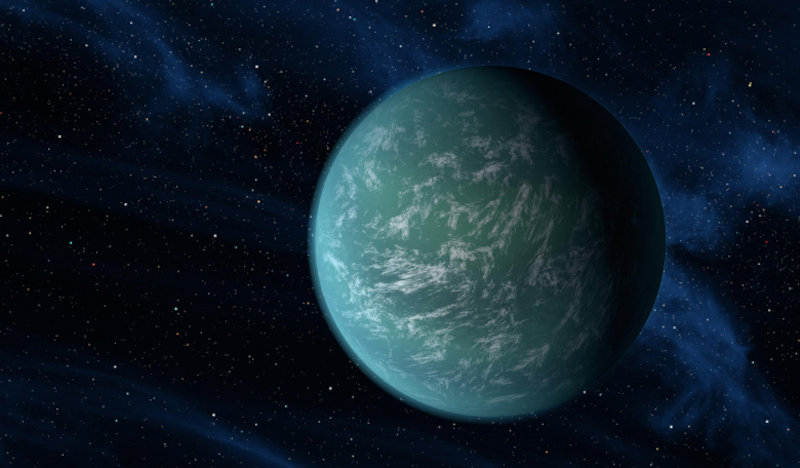
Mars may once have been a blue and water-covered world long before Earth even finished forming. That’s the tantalizing finding that researchers from Arizona State University and Stanford University announced on October 18, 2022. Scientists have seen evidence for early lakes, flowing rivers and even oceans in Mars’ past. But now, new atmospheric models plus data from the Curiosity rover support the possibility of an early atmosphere of molecular hydrogen.
The researchers published the peer-reviewed results in the October 1, 2022, (Volume 595) edition of Earth and Planetary Science Letters. There is also a free preprint version available on arXiv.
A denser early atmosphere
We know from the existence of now-dried-up riverbeds and lakes that Mars’ atmosphere must have once been much thicker than it is now. It would have been dense and warm enough for liquid water to remain stable on the surface. It still isn’t clear, however, just how thick and how warm the atmosphere actually was. Were the lakes and possible oceans warm, or were they cold and ice-covered? Scientists have thought for a long time that the atmosphere was largely similar to what it is now, mostly carbon dioxide. Mars, therefore, had an early greenhouse effect until it lost most of its atmosphere to space.
But there are still questions, and some observations by orbiters and rovers don’t easily fit that scenario. This is especially true since the sun was about 30% dimmer at the time than it is today. Some studies show that even with the thick carbon-dioxide atmosphere, maintaining warm temperatures for millions of years might not have been easy. There may now, however, be another solution: molecular hydrogen.
Was Mars a water world before Earth finished forming?
The new study is based on new evolutionary models of Mars’ atmosphere and data from NASA’s Curiosity rover. It suggests that instead of a thick carbon-dioxide atmosphere, Mars’ early atmosphere was primarily hydrogen. Like carbon dioxide, hydrogen is a powerful greenhouse gas. Its presence would help resolve the paradox of how the planet could have been warm enough for liquid water when the sun was 30% dimmer. It’s difficult to explain that with carbon dioxide, since the gas should’ve frozen out, even back then.
The researchers calculated that molecular hydrogen would have been a strong enough greenhouse gas to have allowed water to remain liquid for millions of years. The paper states:
We find that greenhouse warming due to plausible H2 inventories yields surface temperatures high enough to stabilize a water ocean and produce an early hydrological cycle through which surface water can be circulated.
A hydrogen-rich atmosphere
The researchers wanted to determine the composition of Mars’ ancient atmosphere using new evolutionary models. These are the first models to include high-temperature processes associated with Mars’ formation in a molten state and the first oceans and atmosphere.
The result? The primary gases coming from the molten rock would be a mix of molecular hydrogen and water vapor. The water vapor formed clouds in the lower atmosphere, while hydrogen became the main ingredient of the upper atmosphere.
Measurements from the Curiosity rover also support the findings. Lead author Kaveh Pahlevan at Arizona State University and the SETI Institute said:
This key insight – that water vapor condenses and is retained on early Mars whereas molecular hydrogen does not condense and can escape – allows the model to be linked directly to measurements made by spacecraft, specifically, the Mars Science Laboratory rover Curiosity.

Correlation with analysis of other Mars samples
The results from the evolutionary models fit nicely with measurements taken by the Curiosity rover and analysis of other samples. The rover had analyzed the isotopes of hydrogen in 3-billion-year-old clay in Martian rocks. Curiosity found that the deuterium-to-hydrogen (D/H) ratio in the clay was about three times that found in oceans on Earth.
What does that mean? Basically, the ancient hydrosphere of Mars – the surface water reservoir – must have contained a high concentration of deuterium relative to hydrogen. The scientists say that the only way to have that much deuterium was if the hydrogen gas was eventually lost to space. Deuterium molecules are heavier, so they don’t escape to space as quickly.
Correspondingly, the evolutionary models showed that if Mars’ early atmosphere was denser, with hydrogen, any surface water would have been enriched in deuterium by a factor of two to three. That is exactly what Curiosity found. As Pahlevan noted:
This is the first model that naturally reproduces these observations, giving us some confidence that the evolutionary scenario we have described corresponds to the earliest events on Mars.
A habitable environment?
When we hear about planets with hydrogen atmospheres, we tend to think of large gas-giant-type worlds. Those planets have a rocky core with deep, highly pressurized atmospheres not suitable for life as we know it. On Mars, however, the hydrogen atmosphere could have been a good thing. It would have been an atmosphere more like Earth’s, but dominated by hydrogen instead of nitrogen. As the Miller-Urey experiment showed back in 1952, prebiotic molecules will easily form in hydrogen-rich “reducing” atmospheres.
Other studies have also shown that planets with hydrogen atmospheres could be suitable for life.
In that case, the atmosphere of early Mars may indeed have been well suited for the emergence of life. The implication of the new study is that this would have happened well before the Earth even finished forming as a planet. Could Mars have actually had a head start on the development of life? It’s a fascinating possibility.
Bottom line: Researchers say that early Mars likely had a thick hydrogen atmosphere that allowed water to exist for millions of years, even before the Earth had oceans. The findings are based on new evolutionary models of Mars’ atmosphere and data from NASA’s Curiosity rover.
Source: A primordial atmospheric origin of hydrospheric deuterium enrichment on Mars
Source (preprint): A primordial atmospheric origin of hydrospheric deuterium enrichment on Mars











